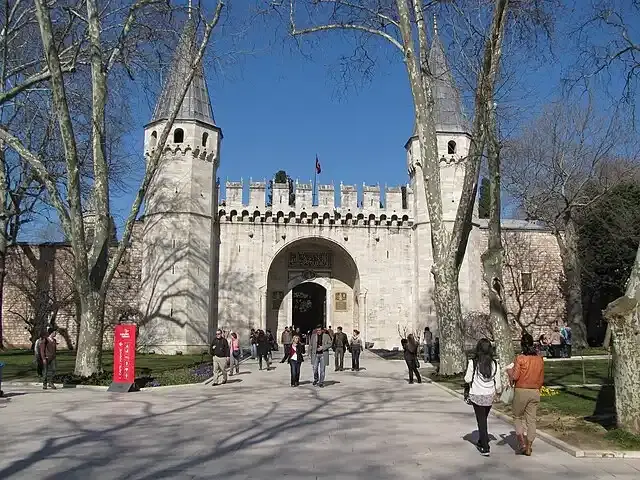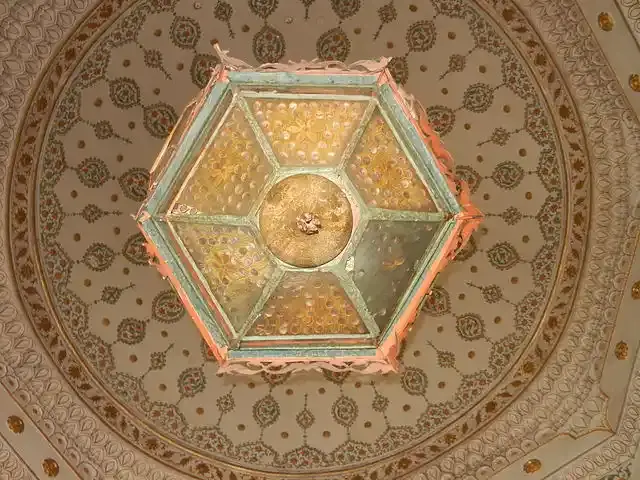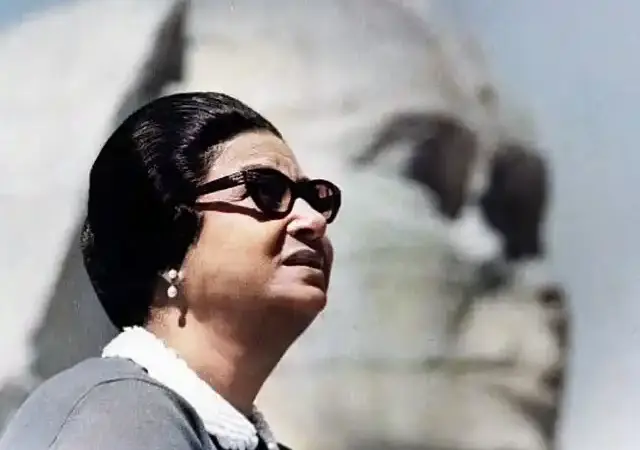Topkapi Palace ... The largest palaces of Istanbul in Turkey
Topkapi Palace is an architectural marvel that celebrates the rich culture and history of the Ottoman Empire. Did you know that the palace kitchen houses a collection of nearly 12,000 pieces of porcelain, including a pot of celadon porcelain from China that, apparently, would change color if the food inside contained poison. If you are in Istanbul, a visit to Topkapi Palace is a must if you want to immerse yourself in the city's rich history and culture.
Show key points
- Topkapi Palace, constructed between 1460 and 1465 by Sultan Mehmed II, served as the imperial residence and administrative hub of the Ottoman Empire for nearly 400 years.
- Originally named "Yenisarai," the palace was later renamed "Topkapi" in the 19th century, evolving through several expansions and surviving major disasters like the 1509 earthquake and the fire of 166
- Distinguished by its eclectic architectural style, the palace showcases a seamless blend of Ottoman, Islamic, and European influences, designed by renowned architects such as Mimar Sinan and Sarkis Balyan.
- ADVERTISEMENT
- Topkapi Palace was transformed into a museum in 1924 and now holds priceless artifacts, including sacred relics, rare manuscripts, Ottoman garments, and the famous Spoonmaker's Diamond.
- The palace kitchen boasts an extraordinary collection of 12,000 porcelain pieces, including a Chinese celadon pot believed to detect poison by changing color.
- Known as the "Palace of Happiness," it emphasized imperial privacy through strict laws and concealed architectural elements like hidden corridors and solid windows.
- Topkapi Palace, designated a UNESCO World Heritage Site in 1985, attracts about 3 million visitors annually, making it one of the most popular tourist sites in Europe.
The reason for naming Topkapi Palace by this name

At first, the palace was called «Yenisarai», which means «New Palace» in order to distinguish it from the previous residence, then the palace took its new name «Topkapi», which means "Sublime Porte" in the nineteenth century, and it was expanded throughout the ages, and renovated after some natural events such as the earthquake of 1509 AD and the fire of 1665 AD.
Recommend
How is Topkapi Palace distinct from the rest of the palaces?
One of the largest surviving palaces in the world, Topkapi Palace was built between 1460 and 1465 on the orders of Sultan Mehmed the Conqueror a few years after his conquest of Constantinople. The palace served as the home of the Ottoman sultans for nearly four centuries. It was also the administrative and educational headquarters of the state. After the death of Sultan Mehmet, about 30 sultans ruled from the palace to renovate it and expand it to its current look – a unique blend of Islamic, European and Ottoman architectural styles. Comprising four courtyards and more than 400 rooms, the palace was home to an estimated 4,000 people, including 300 harem concubines.
Construction of Topkapi Palace

Built by decree of Sultan Mehmed II in 1459, Topkapi's Palace embodies Ottoman architectural splendor. Influenced by Ottoman, Persian and Islamic styles, it was completed in 1465. The architects were chosen for their expertise, skillfully incorporating pointed arches, domes and intricate works into the design of the palace. Notable architects involved in its design and construction include Aladdin, Daoud Agha, Mimar Sinan and Sarkis Balyan. Renowned for its harmonious fusion with diverse influences, the palace stands as a testament to Turkey's cultural and historical richness. Over the centuries, subsequent rulers contributed to its expansion and renovation, cementing Topkapi Palace as a permanent symbol of Ottoman grandeur and architectural prowess.
Topkapi Palace in modern times
Topkapi Palace acquired its current appearance in the sixteenth century after undergoing many renovations and modifications. It is now a complex of four main courtyards interconnected with galleries, corridors, harem rooms, several small courtyards, pavilions and gardens. Topkapi Palace was turned into a museum in 1924 after the abolition of the Ottoman monarchy. It houses an imperial collection of rare books, manuscripts, illustrated volumes, sacred relics of the Prophet Muhammad, early copies of the Qur'an, Ottoman robes, royal treasury, weapons and photographs, as well as a brick dagger and the famous "spoonmaker" diamond.
The Palace of Happiness ... Bricks Qabi

The Ottomans referred to Topkapi Palace as the "Palace of Happiness" because Sultan Mehmed II was very strict in maintaining privacy inside even though the doors were open to the public. The Law of His Law was promulgated in 1481 to ensure that the principle of imperial isolation – the act of remaining completely silent – was followed in the inner courtyard of Topkapi Palace. Solid windows and secret passages were also built to increase the application of this law.
Topkapi Palace is one of the most visited palaces in Europe
The Turkish Ministry of Culture and Tourism has taken care of preserving Topkapi Palace, where ministry officials and armed guards from military patrols guard the complex, and the Tourism Authority maintains the splendor and beauty of the palace, as Topkapi Palace is an authentic part of the historical areas in Istanbul, Topkapi Palace was declared a UNESCO World Heritage Site in 1985, which increased its fame among tourists, as nearly 3 million tourists visit Topkapi Palace annually, making it One of the most frequently visited museums in Europe.
![]()
Career path in the age of technology: strategies for choosing the right specialty
In a fast-changing digital world, choosing a career isn’t just about passion—it’s about understanding tech trends and staying adaptable. By aligning skills with evolving market demands and committing to lifelong learning, young professionals can build strong, future-ready careers and thrive amid constant innovation. more- ADVERTISEMENT
![]()
First Steps to Investing: Practical Tips to Build Your Wealth
Starting your investment journey? Learn the basics, explore different asset types, and build a balanced plan tailored to your goals and risk tolerance. Stay patient, diversify wisely, and avoid common mistakes like investing with borrowed money. Smart moves now can shape a brighter financial future. more- ADVERTISEMENT
![]()
At each moment, there are about 2,000 thunderstorms occurring on Earth.
Thunderstorms are powerful and common, with up to 2,000 happening worldwide at once. Florida tops the U.S. in stormy days, but Venezuela's Lake Maracaibo holds the lightning strike crown. When thunder roars, go inside—lightning is closer than you think and more dangerous than most realize. more- ADVERTISEMENT
![]()
Why is um Kulthum known as Our Lady of Egypt?
Oum Kulthum, known as the "Voice of Egypt" and the "Star of the East," captivated millions with her powerful voice and poetic songs. For decades, her live radio concerts united the Arab world, and her legacy still echoes in Egyptian identity and culture. more- ADVERTISEMENT
![]()
3 inspiring success stories in difficult times
Fred DeLuca’s journey from washing dishes to founding Subway proves that persistence can turn a simple idea into a global empire, while Steve Jobs and Paulo Coelho show how resilience in the face of setbacks can lead to world-changing success and creative brilliance. more- ADVERTISEMENT
![]()
The solar system had nine planets. Maybe he's still doing it? Here's the latest space news today
Pluto’s “demotion” in 2006 marked the start of an exciting new chapter in space discovery, revealing a growing family of dwarf planets and pointing toward a possible mysterious ninth planet. With powerful tools like the James Webb Telescope, we’re closer than ever to uncovering strange new worlds—even beyond our solar system. more- ADVERTISEMENT
![]()
A book that may interest you - don't be too nice
A book that might interest you - Too Nice for Your Own Good more- ADVERTISEMENT
![]()
The most expensive mistakes in history
The most expensive mistakes in history more- ADVERTISEMENT
![]()
The most important technical programs for mobile and computer that are indispensable for everyone
Mobile phones and computers are essential in modern life, and with the right free tools, they can boost your productivity and simplify daily tasks. Apps like Google Chrome, Google Drive, LibreOffice, and VLC Media Player are easy to use and help you stay efficient, secure, and entertained. more- ADVERTISEMENT
![]()
Shocking fact: the moon is moving away from the earth!
The Moon is slowly drifting away from Earth—about 3.8 cm each year—due to tidal friction. This subtle shift has been proven through laser technology since 1969. While it won't escape Earth’s gravity, the distancing affects Earth's rotation, making days longer and altering tides and seasonal temperatures. more- ADVERTISEMENT





















